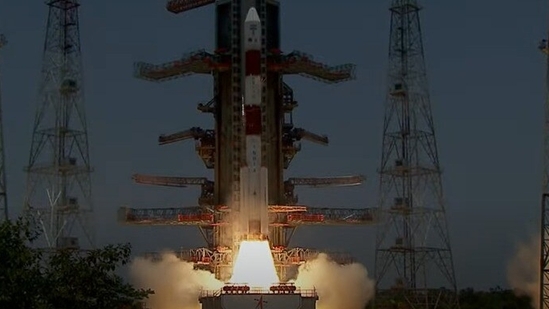Aditya L1 launch: India's first solar mission lifts off from Sriharikota to study Sun
Aditya L1 Launch Updates: India's maiden solar probe aims to study solar winds, which can cause disturbance on Earth commonly seen as auroras.
The Indian Space Research Organisation or ISRO successfully launched the PSLV-C57.1 rocket carrying the Aditya-L1 orbiter, India's maiden solar mission, from the Satish Dhawan Space Centre at Sriharikota in Andhra Pradesh at 11.50am on Saturday. This space-based solar probe aims to study solar winds, which can cause disturbance on Earth commonly seen as auroras.

Named after the Hindi word for the Sun, the Aditya-L1 spacecraft is designed to travel about 1.5 million km over four months to a kind of parking lot in space where objects tend to stay put because of balancing gravitational forces, reducing fuel consumption for the spacecraft. Those positions are called Lagrange Points, named after Italian-French mathematician Joseph-Louis Lagrange.
As the 23.40-hour countdown concluded, the 44.4 metre-tall Polar Satellite Launch Vehicle (PSLV) soared majestically at the prefixed time from the spaceport, located on the Eastern coast about 135 km from Chennai. It will be PSLV's "longest flight" for about 63 minutes.
Among others, it will send pictures of the sun for scientific experiments. According to scientists, there are five Lagrangian points (or parking areas) between the Earth and the Sun where a small object tends to stay if put there. The Lagrange Points are named after Italian-French mathematician Joseph-Louis Lagrange for his prize-winning paper -- "Essai sur le Problème des Trois Corps, 1772."
These points in space can be used by spacecraft to remain there with reduced fuel consumption.
L1 or Lagrange Point
At a Lagrange Point, the gravitational pull of the two large bodies (the Sun and the Earth) equals the necessary centripetal force required for a small object to move with them.
After the lift-off at the Satish Dhawan Space Centre, the scientists would be involved in placing the spacecraft at Low Earth Orbit initially, and later it will be more elliptical.
The spacecraft would be launched towards the Lagrange L1 point using onboard propulsion so that it exits the earth's gravitational Sphere of Influence and cruises towards the L1. Later, it would be injected into a large Halo Orbit around L1 point near the Sun.
The total time from launch to reaching the L1 point would be about four months for the Aditya-L1 Mission, ISRO said.
Why is ISRO aiming to place Aditya-L1 in Lagrange Point 1?
A satellite placed in the halo orbit around the L1 point has the major advantage of continuously viewing the Sun without any occultation/eclipse. This will provide a greater advantage of observing the solar activities continuously. The spacecraft carries seven payloads to observe the photosphere, chromosphere, and the outermost layers of the Sun (the corona) using electromagnetic and particle detectors. Using the special vantage point of L1, four payloads directly view the Sun and the remaining three payloads carry out in-situ studies of particles and fields at the Lagrange point L1.
What information Aditya-L1 is expected to provide?
The suit of Aditya L1 payloads are expected to provide the most crucial information to understand the problems of coronal heating, Coronal Mass Ejection, pre-flare and flare activities, and their characteristics, dynamics of space weather, study of the propagation of particles, and fields in the interplanetary medium, etc.
But why Sun mission?
According to the ISRO, various spacecraft and communication systems are prone to disturbances and therefore an early warning of such events is important for taking corrective measures beforehand. In addition to these, if an astronaut is directly exposed to such explosive phenomena, he/she would be in danger. The various thermal and magnetic phenomena on the Sun are of extreme nature. Thus, the Sun also provides a good natural laboratory to understand those phenomena that cannot be directly studied in the lab.
When Aditya L1 will land?
Aditya L1 is expected to reach its L1 point in the orbit around Sun in 126 days after its launch. However, there is no clear date or time announced by the ISRO till now.
Aditya-L1 will stay in Earth-bound orbits for 16 days, during which it undergoes five manoeuvres to gain the necessary velocity for its journey. Subsequently, Aditya-L1 undergoes a trans-Lagrangian1 insertion manoeuvre, marking the beginning of its 110-day trajectory to the destination around the L1 Lagrange point. Upon arrival at the L1 point, another manoeuvre binds Aditya-L1 to an orbit around L1, a balanced gravitational location between the Earth and the Sun. The satellite spends its whole mission life orbiting around L1 in an irregularly shaped orbit in a plane roughly perpendicular to the line joining the Earth and the Sun.
How Aditya L1 is made?
The seven payloads of Aditya L1 are indigenously developed by different laboratories in the country. Its VELC instrument is made at the Indian Institute of Astrophysics, Bangalore; SUIT instrument at Inter University Centre for Astronomy and Astrophysics , Pune; ASPEX instrument at Physical Research Laboratory, Ahmedabad; PAPA payload at Space Physics Laboratory, Vikram Sarabhai Space Centre, Thiruvananthapuram; SoLEXS and HEL1OS payloads at U R Rao Satellite Centre, Bangalore, and the Magnetometer payload at the Laboratory for Electro Optics Systems, Bangalore. All the payloads are developed with the close collaboration of various centres of ISRO.
How many countries have launched space missions to Sun?
The United States and the European Space Agency (ESA) have sent numerous probes to the centre of the solar system, beginning with NASA's Pioneer programme in the 1960s. But if successful, the latest mission from the ISRO will be the first by any Asian nation to be placed in solar orbit.
(With inputs from agencies)






